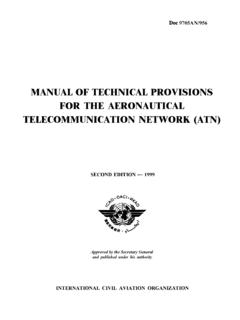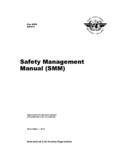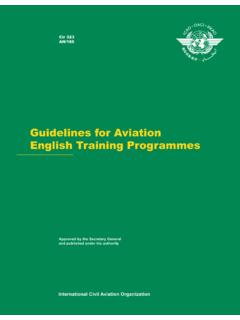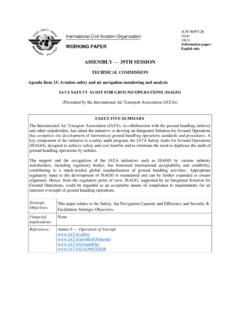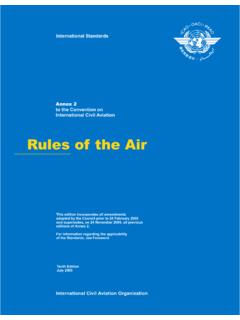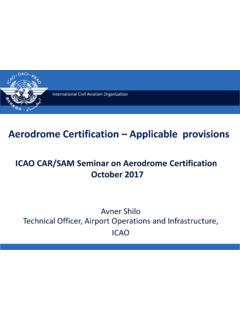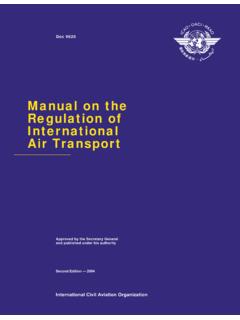Transcription of Aviation Benefits Report 2019 - ICAO
1 Aviation Benefits Report2019 Published through the cooperation and agreement of the global Aviation Industry High-level GroupAviation Benefits 2019 BThe Industry High Level Group (IHLG) was established in September 2013. It is an initiative of the International Civil Aviation Organization (ICAO) Secretary General, bringing together the Heads of four industry organizations: the Airports Council International (ACI), the Civil Air Navigation Services Organisation (CANSO), the International Air Transport Association (IATA) and the International Coordinating Council of Aerospace Industries Associations (ICCAIA). The IHLG is an informal group, which considers matters of global significance to international civil Aviation that can be better addressed in a collaborative arrangement between States and the industry rather than working individually on such Report makes use of material by ACI, CANSO, IATA, ICAO and ICCAIA, as well as the publication of the Air Transport Action Group (ATAG) entitled Aviation : Benefits Beyond Borders (ABBB).
2 While every effort has been made to ensure the quality and accuracy of information in this Report , it is made available without any warranty of any Benefits Report2019civil air navigation services organisationAviation Benefits 20192 Contents5 Foreword6 Executive Summary10 Aviation Overview: From Past to Present11 Exponential Growth of Air Traffic11 Air Travel Affordability13 Air Connectivity13 Regulatory Framework16 Value of Aviation : Economic Benefits17 Direct Impacts18 Indirect Impacts18 Induced Impacts18 Catalytic Impacts18 Aviation Supports Tourism18 A Driver of Global Trade and E-Commerce24 Regional Economic Impact of Aviation28 Value of Aviation : Social Benefits29 Safely Connecting People and Businesses 29 Health and Humanitarian Aid 30 Essential Services 31 Educational Opportunities 32 Improving Quality of LifeAviation Benefits 2019334 Sustainable Air Transport Development38 Modernizing Aviation to Maximize its Benefits39 Funding, Financing and Investment41 Airport Development and Expansion 42 Integrated Transport Planning43 Optimizing Air Traffic Management 44 Engine of Growth: Innovation and Exploration46 Leading Aviation for a Better Future52 Appendix: Regional Summary54 Africa56 Asia and Pacific58 Europe60 Latin America and the Caribbean62 Middle East64 North America66 LDCs, LLDCs and SIDS69 ReferencesAviation Benefits 20195 ForewordThis 2019 edition of the Industry High Level Group (IHLG) s Aviation Benefits Report coincides with the 75th anniversary of the Convention on International Civil Aviation .
3 At this juncture, the Report provides crucial insights into the realization of the vision that has underpinned the Convention and the development of the global Aviation sector throughout the decades: to promote safe, secure, efficient, economically-viable and environmentally responsible air transport as a means to foster international peace and encourage worldwide , 1,303 scheduled airlines operate over 31,717 aircraft, serving 3,759 airports thanks to the support of 170 air navigation services providers1. The Aviation sector is distinct in that it is the only regular means of passenger and cargo transport to be covered by a global de-carbonization goal. This Report illustrates the Benefits of this sector: its support of the expansion of the ability of local communities and businesses to access foreign supplies and markets; its provision of invaluable opportunities for cultural and social exchange; and its enhancement of emergency and humanitarian response capabilities during crises, and public health emergencies.
4 Currently forecasts indicate that air traffic volumes will more than double in the next 20 years. The industries directly supported by Aviation will grow in tandem, increasing business-to-business and consumer Benefits and choices, improving efficiency, spurring job creation, and sparking local and national development. This includes for the Aviation sector itself: increased connectivity leads to further re-investment in Aviation , creating a positive cycle of Aviation development and economic prosperity in those countries and regions that set out suitable plan-ning and investment commitments. Aviation s global stature as an economic engine is evident in the statistics. If the global Aviation sector were a country, its total contribution (direct, indirect, induced and catalytic) of USD trillion to the gross domestic product (GDP), and the million jobs it supports, would be comparable to the United Kingdom s economic size and population2.
5 Despite the long-lasting and vital importance of air transport to global development, the expansion of Aviation today faces many challenges and indeed threats. Continued political support and economic investment will be needed in Aviation sector to meet its potential. Seventy-five years after the global regulatory framework was established, innovation and audacity remain key to the future of Aviation . The information in this Report supports the strategies that will be needed to ensure the continued enhancement of the Aviation GittensDirector GeneralAirports Council InternationalSimon HocquardDirector GeneralCivil Air Navigation Services OrganisationAlexandre de JuniacDirector General & CEOI nternational Air Transport AssociationFang LiuSecretary GeneralInternational Civil Aviation OrganizationEric FanningChairman of the BoardInternational Coordinating Council of Aerospace Industries AssociationsForewordAviation Benefits 20196 Executive SummaryView of the Global Aviation IndustryAviation has continued to expand.
6 It has weathered crises and demonstrated long-term resilience, becoming an indispensable means of transport. Historically, air transport has doubled in size every fifteen years and has grown faster than most other industries. In 2018, airlines worldwide carried around billion passengers annually with trillion revenue passenger kilometres (RPKs). Fifty-eight million tonnes of freight were transported by air, reaching 231 billion freight tonne kilometres (FTKs). Every day, more than 100,000 flights transport almost 12 million passengers and around USD 18 billion worth of BILLION PASSENGERS carried by airlines ( increase from 2017 )48,500 ROUTES worldwide (over 2,900 new routes from 2017 )58 MILLION TONNES OF FREIGHT carried by airlines ( increase from 2017 )54 BILLION KILOMETRES FLOWN by airlines ( increase from 2017 )38 MILLION SCHEDULED COMMERCIAL FLIGHTS flown by airlines ( increase from 2017 )85 MILLION HOURS FLOWNby airlines ( increase from 2017 )Executive SummaryAviation is one of the most global industries: connecting people, cultures and businesses across continents.
7 Colleagues throughout the sector are committed to raising awareness of the Benefits and the role of Aviation . The IHLG organizations have collaborated to provide a comprehensive view of the importance of Aviation in supporting the global economy and generating social Benefits through the prism of sustainable air transport solutions. It is necessary for all stakeholders and partners to work together to maximize the Benefits of air transport, and to support the sustainable growth of Aviation by connecting more people and more places, more Benefits 20197 Aviation Is a Major Contributor to Global Economic ProsperityAviation provides the only rapid worldwide transportation network, which makes it essential for global business. It generates economic growth, creates jobs, and facilitates international trade and to recent estimates by the cross-industry Air Transport Action Group (ATAG), the total economic impact (direct, indirect, induced and tourism-connected) of the global Aviation industry reached USD trillion, some per cent of the world s gross domestic product (GDP) in air transport industry also supported a total of million jobs globally.
8 It provided million direct jobs. Airlines, air navigation service providers and airports directly employed around three and a half million people. The civil aerospace sector (the manufacture of aircraft, systems and engines) employed million people. A further million people worked in other on-airport positions. million indirect, induced and tourism-related jobs were supported by estimates do not include other economic Benefits of Aviation , such as the jobs or economic activity that occur when companies or industries exist because air travel makes them possible. They also do not include the intrinsic value that the speed and connectivity of air travel provides, or domestic tourism and trade, as well as foreign direct investment simulated by good air transport connections, which is crucial to developing productive assets for economic growth in the long term. Including these would increase the employment and global economic impact numbers of the industries that relies most heavily on Aviation is tourism.
9 By facilitating tourism, air transport helps generate economic growth and alleviate poverty. Currently, approximately billion tourists are crossing borders every year, over half of whom travelled to their destinations by air. In 2016, Aviation supported almost 37 million jobs within the tourism sector, contributing roughly USD 897 billion a year to global transport is a driver of global trade and e-commerce, allowing globalization of production. The small volumes of air cargo amount to big values in world trade. In 2018, USD trillion worth of goods were expected to be transported internationally by air, representing 35 per cent of world MILLION JOBS SUPPORTED PER CENT OF GDP SUPPORTEDUSD TRILLION ECONOMIC IMPACTA viation s global employment and GDP impact4$ billion$ billion$ billion$ millionECONOMIC BENEFIT (GDP)$ millionEMPLOYMENT(JOBS) millionTourismcatalytic InducedIndirectAviationdirectAviation Benefits 20198trade by value, despite representing less than 1 per cent by volume8.
10 Aviation s advantage over other modes of transport in terms of speed and reliability has contributed to the market for same-day and next-day delivery services and transportation of urgent or time-sensitive goods. Around 90 per cent of business-to-consumer (B2C) e-commerce parcels are currently carried by air. The e-commerce share of scheduled international mail tonne kilometres (MTKs) grew from 16 per cent to 88 per cent between 2010 and 2018 and is estimated to grow to 96 per cent by Provides Significant Social BenefitsThe availability of reliable air transport services provides people with access to what they need: better living standards, food, healthcare, education, safe communities and spaces, etc. Aviation is by far the world s safest and most efficient mode of long-range transportation. It often serves as the only possible means of transportation to provide health care and food supplies to many remote communities, and it is a fast and reliable way to deliver urgent humanitarian aid during emergencies caused by natural disasters, famine and war.


